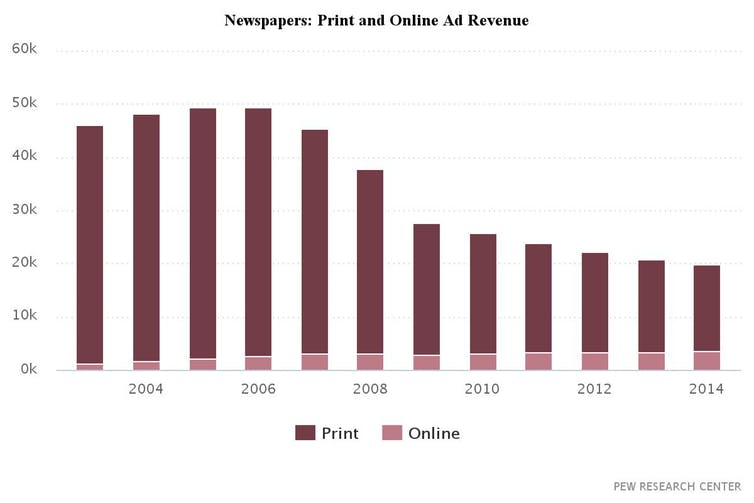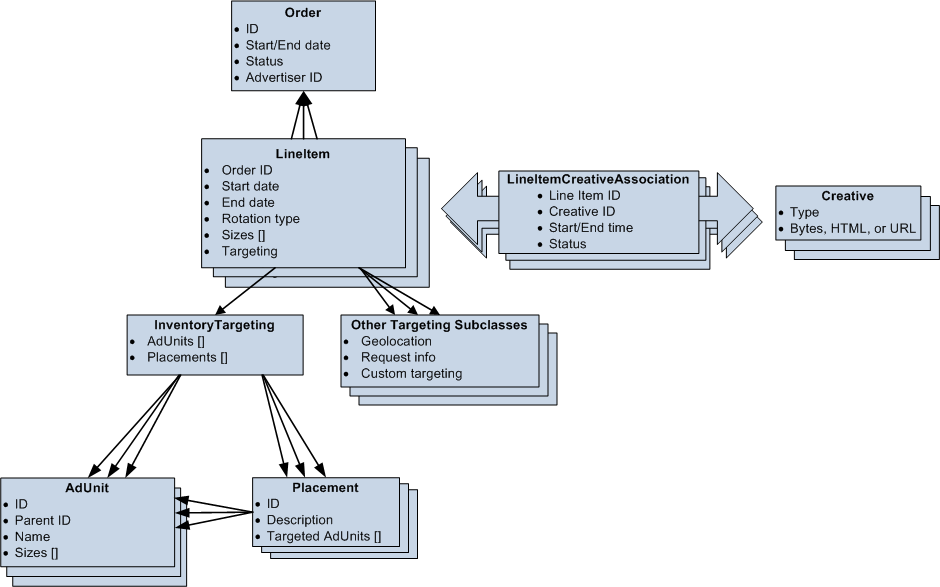
Artificial Intelligence and Events: Making 4 Publications Prosper
Experimentation keeps businesses alive, but flexibility lets them prosper.
Many news organisations are embracing diversification to explore new streams of revenue. It’s not quite news that people don’t buy newspapers as often as they used to, hence the ongoing interest in new ways to increase profitability in the sector.
Simply moving articles online isn’t enough. When it comes to making money from journalism, getting ad revenue online is no mean feat, meaning that a lot of the ad revenue that publications get is still tied up in their offline efforts, the circulation of which, as mentioned, is in decline:

Source: Pew Research Centre
To work on that problem, and the others stopping publications from making money in the digital age, four main players in the journalism world spoke with us. We explored how new technologies, artificial intelligence and events are bringing solutions to the newsroom:
1) Independent News and Media | Making Ads Smarter
The print circulation of INM news publications is 1.61 million. Their digital readership, however, is 24.2 million.
These numbers illustrate the global shift towards digital consumption, but the more remarkable evidence here is how INM have made things work alongside this change. Their digital advertising opportunities are some of the more sophisticated on offer on the market, defying the typical struggles of their competitors. Their “editorial CMS can generate the most popular and relevant keywords within articles and across topics, so (they) can target your campaign exactly as you want.”
DFP Premium is something a lot of publishers are familiar with, but to explain the system briefly, it’s a Google-owned ad server that allows publishers to more effectively track and manage their ad campaigns.
To speak to its technological sophistication, here’s how the API works:

Source: Double Click by Google
These layers of decision making allow for advanced modeling and pattern recognition. In addition to this, and throwing AI into the mix, the system is able to take advantage of Google’s AdWords machine learning and AdSense contextual matching to help deliver ads to users who are more likely to react to them.
However, even when you can report on impressions, click-through rate, the next steps visitors take, and daily changes, sometimes you still can’t make enough money. But, combining the power of this with live events is quite the pairing:
“Facebook and Google are dominating the ad sector. They are leveraging our content to sell ads on their platform,”
… said Brendan Hughes, Chief Digital Officer at Independent News & Media. Publications like Hughes’ are embracing events as a solid revenue stream, “we have what other brands want. We have a highly engaged audience that we can influence to go places.”
2) The New York Times | Tracking the Impact of News Beyond the Web Page
Publications aren’t stopping here. Event production and curation are huge players when it comes to their engagement efforts, but there are yet more combinations where artificial intelligence and events can work hand-in-hand.
The New York Times have their own R&D to facilitate media innovation. Publications understand that they can’t afford to be caught out when it comes to new innovations that allow attendees to have meaningful event experiences.
The NYT uses in-house artificial intelligence and machine learning to optimise how they reach and engage readers. To take stock of their efforts, we need only look to Cascade; a system used to dig into news and better understand its influence.
Source: Cascade / Jer Thorp, Mark Hansen, Jake Porway / NYT R&D Lab from Center for Spatial Research on Vimeo.
Cascade links browsing history to social shares, and illustrates the journey of that information from publisher to other online areas. The NYT “use(s) this tool to help publishers, marketers and public relations professionals to investigate several questions.”
For example, are certain people more influential on certain topics? How does content impact the conversations around issues? What variables impact the reach of social media messaging? All of these tie neatly together to form a symbiotic relationship between artificial intelligence, data modelling, and how to optimise an event for engagement.
Recently, the NYT was host to such events as a The Journalist and the Source: How Reporters Get Subjects to Tell Their Stories, and How to Understand Our Times: The #MeToo Moment. By using advanced technological implementations to better understand what’s shaping journalism, as well as its expert events, the NYT is now at the helm of how the world learns about and engages with current affairs. Proving, again, that artificial intelligence and events can go hand-in-hand towards improving brand reputation and audience engagement.
3) The Telegraph | Event Networking, But Make it AI
Dan Loosemore, director of B2B media and events at The Telegraph shared the following with us,
“We work with Grip, an event networking tool powered by AI. They white label the app specifically for the event. What that means is we’re getting best practice. We also get consistency of brand and messaging across all of the events.”
Some of the attendees at The Telegraph’s events are business leaders, a cohort of people that expect to know the ROI of their time.
Grip works by recommending peers to meet at an event, allowing you to schedule time with them, and helping you to save your new connections’ contact details, thus growing your network.
As anyone in industry will attest to, making connections at events can lead to new business partnerships, whether that be with investors or consumers. By incorporating this innovation, Loosemore has enhanced their event experience and made the event value tangible.
4) TechCrunch | Using AI to Connect Startups and Investors
TechCrunch host Disrupt Conference is a behemoth event that has hosted anywhere from 3,000 to 6,000 attendees in previous years. Leslie Hitchcock, formerly TechCrunch’s director of events and now in charge of international event expansion, is keenly aware of the limits of huge events.
“Disrupt used to be a really large free-for-all. It was overwhelming for startups and investors. We wanted Disrupt to be an efficient place for people to be. A place where they find their next investments, or find their next mentor, or get a network together.”
That pain point for TechCrunch’s attendees inspired them to create new products like CrunchMatch, an investor and startup matching service. “We piloted it in 2015 and we had 40 meetings but this year in New York we have 443 meetings. We want these innovations to provide additional value to our attendees.”
Publications are keenly aware of the value of their reader community. They also are realistic about the challenges of the current advertising model. Events are a great fit for them as they have discovered, but at the same time their readers are expecting meaningful connections. In many ways the event organiser at a publication is attempting to mirror the intimacy that a reader has with the written word when they read their articles. It’s a one-on-one relationship. Their clever use of event innovation is allowing them to enhance the brand rapport.
So, Is Artificial Intelligence the Future of Events?
An event is always a complex mix of what the audience needs and what the organiser uses to make their experience as memorable and engaging as possible. Artificial intelligence at events has already dawned, so it’s time we woke up to the power it holds for event curation.
Even if you find yourself (and your conference) outside of the publishing world, one of the greatest benefits of artificial intelligence for events is how limitless is it. The only thing that renders a system like that not useful is a reluctance to let them inspire you.
While you shouldn’t expect to see a fully-blown artificial intelligence engine at every conference you go to from now on, it’s clear to see that there are ways to use this technology that push events further towards fascinating the attendees that go to them. Innovation is what keeps event organisers building and pushing, and AI can (and should) be one more tool in their boxes of tricks.